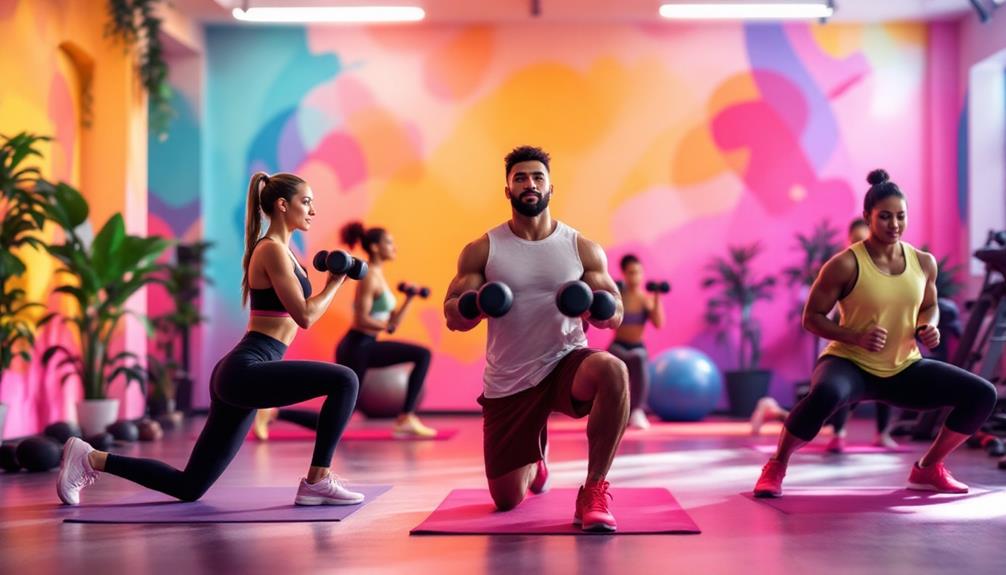To maximize your strength gains, focus on these top seven resistance training exercises. Start with Barbell Squats, which engage your legs and core effectively. Next, incorporate Deadlifts to target your posterior chain. Don't skip the Bench Press for upper body power. Pull-Ups are excellent for back strength, while the Overhead Press works your shoulders effectively. Bent-Over Rows help build a strong back, and finish with Lunges to enhance leg stability. Together, these exercises will enhance your overall strength. Each offers unique benefits, so let's explore how to perform them correctly for the best results.
Core Insight
- Barbell squats build lower body strength and improve core stability, making them essential for overall muscle development.
- Deadlifts target multiple muscle groups, enhancing posterior chain strength and promoting functional fitness.
- The bench press is crucial for upper body strength, emphasizing the chest, shoulders, and triceps through controlled movements.
- Pull-ups develop back and arm strength, while engaging the core for stability, making them an effective bodyweight exercise.
- Overhead presses strengthen shoulder and upper body muscles, promoting stability and power during functional movements.
Barbell Squats

Stand with your feet shoulder-width apart. Keep your chest up and your core tight. Lower your body by bending your knees and hips. Make sure your knees stay in line with your toes. Try to lower yourself until your thighs are parallel to the ground. If you want to make your squats harder, you can use resistance tubes. These handy tools can be used in many exercises, including squats, to work different muscles.
Push through your heels to go back to the starting position. Aim to include barbell squats in your routine two to three times a week for the best results. Over time, you will see improvements in your strength, stability, and overall athletic performance.
Deadlifts

After you get the hang of barbell squats, adding deadlifts to your workout can boost your strength training even more. Deadlifts work your entire back side, helping you build muscle and improve your balance. If you're starting out and want a lower intensity option, using resistance bands is a great choice. They allow you to adjust the resistance to match your fitness goals. Here are some important tips for your deadlift routine:
- Focus on Form: Keep your back straight and engage your core to avoid injury.
- Foot Position: Stand with your feet shoulder-width apart for the best balance and power.
- Grip: You can use a double overhand grip or a mixed grip to hold the barbell securely.
- Increase Weights Slowly: Add weight gradually to prevent strain and keep making progress.
Bench Press

Mastering the bench press can greatly boost your upper body strength and muscle definition. This exercise mainly works your chest, shoulders, and triceps. To do it correctly, lie flat on a bench with your feet firmly on the ground. Hold the barbell with your hands a little wider than shoulder-width apart. If you're working out at home, you can use resistance bands as a good alternative to weights. They allow for different levels of resistance and can be used for various bench press exercises.
Lower the bar to your chest while keeping your elbows at about a 45-degree angle. Push the bar back up quickly but stay in control. Remember to breathe out as you lift the bar and inhale as you lower it.
Start with lighter weights to get your form right before you increase the weight. Being consistent is important, so try to include the bench press in your routine at least once a week to see the best results.
Pull-Ups

- Grip: Hold the bar with your palms facing away and hands a bit wider than your shoulders. This helps you use your muscles better.
- Movement: Go up and down slowly. This way, you activate your muscles more. If you're a beginner, try using resistance bands. They can help you do pull-ups and increase your reps.
- Core: Keep your stomach tight to stay stable during the exercise.
- Getting Better: If you're new, use resistance bands or practice lowering yourself slowly to build strength over time.
Adding pull-ups to your exercise routine can help you get stronger and improve your fitness.
Overhead Press

The overhead press is a great exercise that works your shoulders, triceps, and upper back. It is important for building strength in your upper body. You can also use resistance bands for this exercise, which provide different levels of resistance and are easy to use at home.
To do the overhead press, stand with your feet shoulder-width apart. Hold a barbell or dumbbells at shoulder height with your palms facing forward. Keep your core tight and your back straight as you press the weight up over your head. Your elbows should be slightly in front of the bar. Fully extend your arms, then lower the weight back to shoulder height in a controlled manner. Aim for 3 to 4 sets of 8 to 12 repetitions.
Adding the overhead press to your workout routine will help increase your pressing strength and improve your performance in sports and other activities.
Bent-Over Rows

To do bent-over rows correctly, follow these four simple tips:
- Foot Position: Stand with your feet shoulder-width apart for better balance.
- Hinge at the Hips: Bend your knees slightly and lean forward from your hips, keeping your back straight.
- Grip: Hold the barbell or dumbbells with an overhand grip and pull them toward your waist.
- Controlled Movement: As you lift, squeeze your shoulder blades together and maintain control throughout the exercise.
After your workout, consider using infrared heat pads to help reduce muscle soreness and aid recovery. These can be especially useful for the back muscles worked during bent-over rows.
Add bent-over rows to your exercise routine for improved strength.
Lunges

Lunges are a great exercise for building lower body strength and improving your balance. They work your quads, hamstrings, and glutes, and they also engage your core. You can do lunges in different ways, like forward, reverse, or lateral lunges.
Benefits of Lunges
| Benefit | Description |
|---|---|
| Strength Building | Works several muscle groups at once. |
| Balance Improvement | Helps with stability and coordination. |
| Flexibility Increase | Increases your range of motion. |
| Core Engagement | Strengthens your abdominal muscles. |
To do a lunge, step forward with one leg and lower your hips until both knees are at about 90-degree angles. Keep your core tight, then return to the starting position. Adding lunges to your routine can help you gain strength effectively.
Frequently Asked Questions
How Often Should I Perform Resistance Training Each Week?
You should aim for resistance training two to four times a week, depending on your fitness level and goals. Make sure to include rest days to allow your muscles to recover and grow stronger.
What Should I Eat to Support Muscle Recovery?
To support muscle recovery, you should eat a balanced diet rich in protein, healthy fats, and carbohydrates. Include lean meats, nuts, fruits, and whole grains, and don't forget to stay hydrated for best recovery.
Is It Safe to Lift Heavy Weights Without a Spotter?
About 30% of weightlifting injuries occur without a spotter. You can lift heavy weights safely, but always prioritize technique, use safety equipment, and make sure you're in a controlled environment to minimize risks. Stay cautious!
Can I Do Resistance Training if I Have Joint Pain?
If you've got joint pain, you can still do resistance training, but it's important to choose low-impact exercises. Always listen to your body, modify movements, and consider consulting a professional to guarantee safety and effectiveness.
How Do I Track My Progress Effectively?
To track your progress effectively, keep a workout journal detailing your exercises, sets, reps, and weights. Regularly assess your performance and adjust your goals, ensuring you stay motivated and aware of your improvements.

